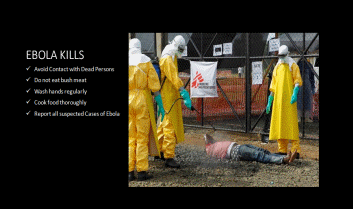Ebola is a non-discriminatory disease. For instance, it has affected health professionals and their patients alike. Its severity and non-discriminatory nature explain why, globally, people fear the disease (World Health Organization, 2015). The lack of a cure, or vaccine, has further compounded this problem. These factors explain why communities have struggled to survive under the threat, fear, and paranoia associated with Ebola. The proposed public health campaign targets everyone in Sierra Leone because everybody is at risk of contracting the disease. Furthermore, all people are responsible for preventing the further spread of the disease. Indeed, families, community leaders, and governments should support health-promoting behaviors because this is the only way communities could protect themselves from the adverse effects of the disease. Based on these dynamics, collectively, the public health campaign targets everyone in Sierra Leone.
Sierra Leone has endured the most of Ebola, because of unique cultural, social, and political issues in the country (World Health Organization, 2015). For example, culturally, hugging and kissing dead bodies partially contributed to the spread of the disease (World Health Organization, 2015). Politically, the lack of sufficient investments in the country’s health sector created an ineffective response to the outbreak (World Health Organization, 2015). Although these issues collectively contributed to Sierra Leone’s poor response to the outbreak, the proposed public health campaign would only focus on changing social factors that contribute to the spread of the disease. Particularly, it would create awareness about the effects of retrogressive cultural practices on the increased spread of Ebola in the country. For example, it would educate people about the importance of proper disposal of dead bodies and the need to report suspected cases of Ebola to health authorities. Ultimately, the goal of the public health campaign would be to increase trust between health workers and the residents of Sierra Leone (Romer et al., 2009).
Communities would benefit from the proposed public health campaign by minimizing their risks of contracting Ebola. For example, by increasing awareness about the dangers of failing to report suspected cases of Ebola, the residents of Sierra Leone would lower their risk of contracting the disease because health officials would test and quarantine suspected patients. Similarly, the audience would lower the risk of a resurgence of the virus if they adopt some of the actions proposed in the public health campaign. For example, through the campaign, they would learn about the dangers of eating bush meat because health officials suspect that the first case of Ebola emerged from bushmeat consumption (World Health Organization, 2015). By stopping this practice, the residents of Sierra Leone would lower the risk of Ebola resurgence after its containment.
Public health campaigns have different types of appeals. The most common types are rational appeal, emotional appeal, threat appeal, positive emotional appeal, and humorous appeal. The proposed Ebola public health campaign would have a threat appeal because it would warn people about the dangers of abating specific cultural practices that promote the spread of the disease. The fear appeal is right for this campaign because it would create a high level of perceived severity and susceptibility to the disease (Witte & Allen, 2000). This appeal is more effective in changing cultural practices that most Sierra Leone communities have practiced for generations. Based on this understanding, Witte and Allen (2000) support the fear-based public health campaign by saying, “Fear appeals motivate adaptive danger control actions such as message acceptance and maladaptive fear control actions such as defensive avoidance or reactions” (p. 591). The success of the proposed public health campaign depends on these actions. The diagram below shows a draft of the public health poster

References
Romer, D., Sznitman, S., DiClemente, R., Salazar, L. F., Vanable, P. A., Carey, M. P., …Juzang, I. (2009). Mass Media as an HIV-prevention Strategy: Using Culturally-Sensitive Messages to Reduce HIV-associated Sexual Behavior of at-risk African-American Youth. American Journal of Public Health, 99(12), 2150–2159.
Witte, K., & Allen, M. (2000). A Meta-Analysis of Fear Appeals: Implications for Effective Public Health Campaigns. Health Education & Behavior, 27(5), 591-615.
World Health Organization (WHO). (2015). Sierra Leone: a traditional healer and a funeral. Web.